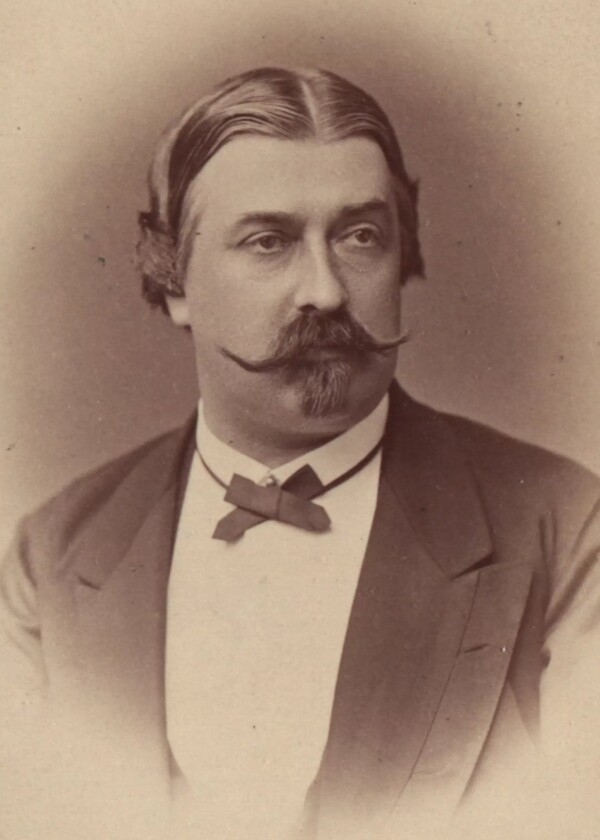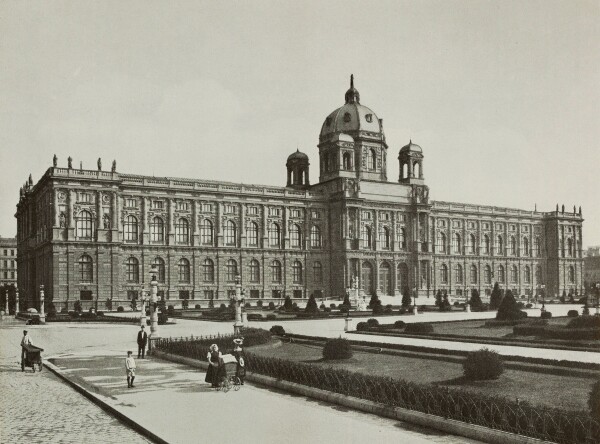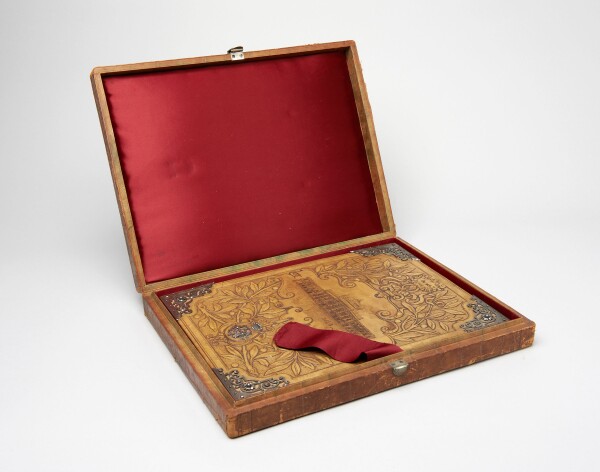Carl Hasenauer

Carl Hasenauer photographed by Ludwig Angerer, around 1868, Wien Museum
© Wien Museum

Court Museum of Art History, around 1900
© Wien Museum
Carl Hasenauer worked as an independent architect in Vienna. The Vienna Burgtheater and the Hermesvilla in the Lainzer Tiergarten, for which the “Künstler-Compagnie” contributed decorations, are today considered his most important architectural works.
Carl Freiherr von Hasenauer, born in Vienna in 1833, spent his schooling and training years in Vienna, Dresden and Brunswick and subsequently studied at the Vienna Academy of Fine Arts, attending the architecture class of Eduard van der Nüll and August Sicard von Sicardsburg. Hasenauer also trained as a builder and carpenter and went on extended study trips to France, Italy and Germany. He graduated successfully in 1854 and soon began working as an independent architect. He became a member of the newly founded Cooperative of Visual Artists in Vienna in 1861.
Prestigious Commissions
The young architect saw his first major successes in 1860/61 with the participation in the international competitions for the facade of the Cathedral of Florence and for the Vienna State Opera. In 1867, Hasenauer was also belatedly admitted to the competition for the Imperial-Royal Court Museums (now Kunsthistorisches Museum and Naturhistorisches Museum). Initially only Theophil Hansen, Heinrich Ferstel and Moritz Löhr had been invited to participate. Hasenauer’s architectural concept was preferred, which led to heated debates. Hasenauer even temporarily left the Cooperative of Visual Artists in Vienna. With Gottfried Semper providing a new direction for the project with his idea of an “Emperor’s Forum,” a concept that combined Semper’s and Hasenauer’s designs was finally chosen for the court museums.
In 1871, Hasenauer was hired as the leading architect for the World’s Fair that was to be held in Vienna two years later. He was primarily in charge of constructing the central exhibition building – the so-called Rotunde. The title of “Freiherr” was later bestowed on him in recognition of his organizational achievements in this project.
Carl Hasenauer: Design sketches for the bedroom of the Hermesvilla, The Albertina Museum, Vienna
©

Homage address for Carl von Hasenauer, 1888/89, Theatermuseum
© KHM-Museumsverband
Between 1882 and 1886, Hasenauer realized the construction of the Hermesvilla in the Lainzer Tiergarten. He had been personally commissioned by Emperor Franz Joseph I, who intended to bestow the country residence on his wife, Empress Elisabeth, as a gift. The painter Hans Markart had been originally commissioned to create the decorations for the bedroom and the salon. After his unexpected death, the “Künstler-Compagnie” and other artists completed the decorations in 1884/85.
Between 1874 and 1888, Hasenauer was also in charge of building the Vienna Burgtheater (previously Imperial-Royal Court Theater) on Vienna’s Ringstraße. He collaborated with Gottfried Semper in the creation of the designs for the prestigious building; following artistic disputes, Hasenauer completed the building alone. The project brought about another collaboration with the “Künstler-Compagnie”: In 1886, Hasenauer commissioned Gustav Klimt, Ernst Klimt and Franz Matsch – presumably on the recommendation of Rudolf von Eitelberger – to create the artistic decorations for the stairwells of the theater.
Even though no further collaborations took place, two additional points of contact can be identified between Gustav Klimt and the architect: In Klimt’s watercolor Auditorium of the Old Burgtheater (1888/89, Wien Museum, Vienna), Carl Hasenauer and his family are depicted among other well-known figures of public life. Furthermore, Gustav Klimt was involved in the creation of the Homage Address to Carl von Hasenauer (1888/89, Theatermuseum, Vienna), a token of gratitude which the builder received on the occasion of the completion and opening of the Burgtheater.
Later Professional Career
Two years before his death, Hasenauer was appointed the rector of the Academy of Fine Arts, where he had been the head of the Specialist Class of Architecture from 1884. He died in January 1894 and was buried at Vienna’s Central Cemetery.
Literature and sources
- Österreichische Akademie der Wissenschaften (Hg.): Österreichisches Biographisches Lexikon 1815–1950, Band 2, Vienna 1994.
- Felix Czeike (Hg.): Historisches Lexikon Wien, Band 3, Vienna 1994, S. 69-70.
- Tobias G. Natter (Hg.): Gustav Klimt. Sämtliche Gemälde, Vienna 2012, S. 536-537.
- Ursula Storch (Hg.): Klimt. Die Sammlung des Wien Museums, Ausst.-Kat., Vienna Museum (Vienna), 16.05.2012–07.10.2012, Vienna 2012.
- Architektenlexikon. Wien 1770–1945. Carl Hasenauer. www.architektenlexikon.at/de/1096.htm (04/07/2020).
- Andreas Nierhaus (Hg.): Der Ring. Pionierjahre einer Prachtstraße, Ausst.-Kat., Vienna Museum (Vienna), 11.06.2015–04.10.2015, Vienna 2015.

